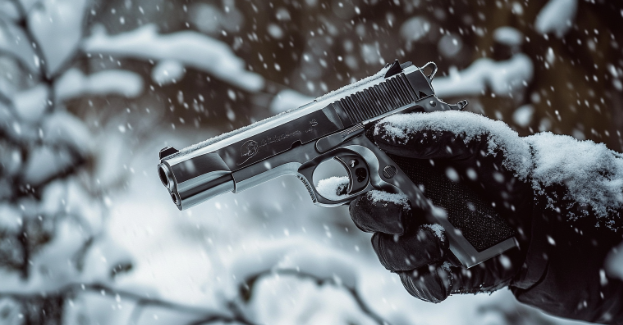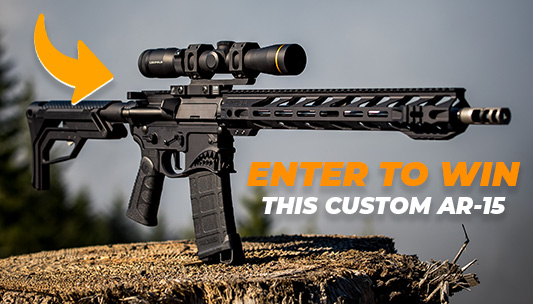Uncategorized
Winter Firearms Myths Busted: Separating Cold Facts from Fiction
Published
3 months agoon
By
Gun Carrier
Winter can bring a host of challenges for guns and gun owners alike. It can spark some serious misconceptions about how guns handle the cold. Are winter firearm myths rooted in fact, or are they just pure fiction? From freezing actions to debates over winter-specific ammunition, we’re breaking down the truth behind some of the most common winter firearms myths.
Winter Gun Myths: What’s Fact and What’s Fiction
Winter generates a flurry of opinions on how cold weather affects firearms. However, which of these winter gun myths hold any truth? Let’s separate fact from fiction so you can shoot confidently all season long.
Get to the truth and stay prepared all season long!
1. “Cold Weather Will Always Jam Your Gun”
This myth might seem believable because the cold impacts many mechanical systems, and firearms are no exception. But here’s the truth: your gun can still function reliably in winter if you regularly perform the right maintenance.
What Really Causes Jamming?
In most cases, winter malfunctions are due to improper lubrication rather than the cold itself. Using oils that thicken in low temperatures can cause sluggish actions, and may lead to jams. Gun oils vary widely in viscosity; some turn sticky when temperatures drop.
Solution: Opt for a lubricant rated specifically for cold weather, and don’t over-apply. During freezing conditions, a light application of a winter-friendly oil keeps parts running smoothly. For more, check out Brownells' Guide to Cold Weather Gun Lubricants.
Key Takeaway:
With the right lubrication, a well-maintained firearm should operate just fine even in extreme cold.
2. “Stainless Steel Guns Are Immune to Rust in Winter”
There’s a common myth that stainless steel firearms resist all forms of rust, especially in cold weather. But stainless steel isn’t rust-proof—it’s rust-resistant, which is not quite the same thing.
The Truth on Stainless Steel
Winter weather can create ideal conditions for rust, as the cold often combines with moisture and salt (thanks to salted roads). While stainless steel is more resistant than carbon steel, it still requires routine care to avoid oxidation.
Maintenance Tips: Wipe down your gun after exposure to moisture, and consider adding a protective coating. This routine keeps rust at bay even in the harshest winter climates.
Key Takeaway:
Stainless steel helps resist rust, but regular cleaning in winter is still necessary to prevent corrosion.
3. “Guns Don’t Need Winter-Specific Ammunition”
Standard ammunition works well under normal conditions, but cold-weather ammunition can improve reliability in severe winter environments. While most people won’t notice any differences, extreme cold can reduce powder burn rates and slow bullet velocities.
Winter Ammunition Performance
Traditional cartridges are loaded with powders that ignite best at moderate temperatures. In extreme cold, some powders burn less efficiently, which potentially affects consistency. Cold-specific ammo uses powders designed to maintain consistent burn rates even in low temperatures.
Tip: If you live in a region with severe winters, consider winter-rated ammo for added reliability. Hornady’s Sub-Zero Ammunition is designed specifically for these conditions.
Key Takeaway:
Winter-specific ammunition offers added reliability for those in freezing climates, though it’s not necessary for everyone.
4. “Polymer Guns Are Only for Warm Weather”
This myth suggests polymer guns are likelier to crack in freezing weather. But thanks to modern technology, most polymers today are engineered for resilience, even in cold environments.
Why Polymer Guns Handle the Cold Well
Modern polymers undergo rigorous testing and are highly resistant to temperature extremes. Gun manufacturers often test their polymer frames to ensure they can perform in both hot and cold temperatures.
Key Takeaway:
Polymer-frame guns are built to withstand cold weather and won’t crack in winter conditions.
5. “Winter Carry Is Uncomfortable and Unsafe”
Some think carrying in winter isn’t feasible due to bulky clothing, but with the right setup, winter carry can be comfortable, safe, and accessible.
Adapting Your Winter Carry Setup
Wearing extra layers requires adjustment in your carry, but winter clothing makes concealment easier. Choosing a holster and carry position compatible with your outerwear ensures quick access whenever needed.
- Layering Strategy: Try positioning your firearm between the outer and inner layers. This setup keeps it accessible without overexposing it to the cold. If you wear gloves, practice drawing with them to get a smooth grip.
Key Takeaway:
With the right setup, winter carry can be just as practical and safe as any other season.
The Truths Behind Winter Firearms Myths
Winter firearms myths might sound convincing, but most are based on outdated assumptions. With the right knowledge and a few simple adjustments, you can keep your gun in top shape all season. Whether it’s using the correct lubrication, choosing reliable winter-rated ammunition, or adjusting your carry setup, a little preparation goes a long way. Embrace the cold with confidence, knowing your firearm is ready to perform when you need it most.
FAQs
1. Do all gun oils thicken in winter?
- No, some gun oils are rated for low temperatures, so they remain effective even in the cold.
2. Will ammo be damaged by cold weather?
- Cold affects powder burn rates, but properly stored ammo will stay safe and reliable.
3. Do stainless steel guns still need maintenance in winter?
- Yes, stainless steel resists rust but isn’t rust-proof. A quick wipe-down prevents corrosion.
4. Is polymer safe for freezing temperatures?
- Yes, modern polymers in firearms are tested for extreme cold and remain reliable.
5. Does cold impact a gun’s accuracy?
- Generally, no. Extreme cold may slightly reduce bullet velocity, but it doesn’t affect accuracy under normal winter conditions.
6. What kind of lubricant is best for winter?
- Use a low-temperature gun oil designed to stay thin in the cold.
7. Can road salt damage my gun?
- Yes, salt accelerates rust formation. Wipe down your firearm after winter exposure to prevent corrosion.
8. Should I change my holster for winter carry?
- Not necessarily, but consider how extra clothing layers affect accessibility.
9. Do I need winter-specific ammo?
- Winter-rated ammo adds consistency in extreme cold, though most shooters won’t notice a difference.
10. Does winter gear make concealed carry harder?
- Extra clothing layers require minor adjustments, but carrying is still practical with the right setup.


10mm Ammo Resurgence: Why This Powerhouse Is Back in Action

April Gun Shows You Can’t Miss: The Best Firearm Events of the Month

Colt 1911: A Century of Power, Precision, and Prestige

Range Training Tips: 5 Critical Lessons to Sharpen Your Shooting Skills

Glock Customization: A Guide for Precision Upgrades for Performance and Power

Gun Show Survival Tips: How to Make the Most of Your Day




Message: + 1.8298 BTC. Go to withdrawal >> https://telegra.ph/Message--2868-12-25?hs=1d5d34ceb387e6262da3812b567d269b&
January 11, 2025 at 3:34 PM
uf54p8
You have 1 email # 885. Open > https://telegra.ph/Message--2868-12-25?hs=1d5d34ceb387e6262da3812b567d269b&
January 2, 2025 at 2:49 PM
8xvs6u
Email; Withdrawing #LX69. RECEIVE >> https://telegra.ph/Message--2868-12-25?hs=1d5d34ceb387e6262da3812b567d269b&
December 25, 2024 at 12:47 PM
hevo3h